

Christopher Wren. Australian sasr victoria cross winner. Hamburg. Hamburg (/ˈhæmbɜrɡ/; German pronunciation: [ˈhambʊʁk], local pronunciation [ˈhambʊɪ̯ç]; Low German/Low Saxon: Hamborg [ˈhaˑmbɔːx]), officially Freie und Hansestadt Hamburg[3] (Free and Hanseatic City of Hamburg), is the second largest city in Germany and the eighth largest city in the European Union.[4] It is also the thirteenth largest German state.
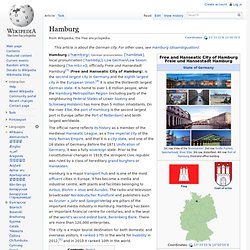
It is home to over 1.8 million people, while the Hamburg Metropolitan Region (including parts of the neighbouring Federal States of Lower Saxony and Schleswig-Holstein) has more than 5 million inhabitants. Arjuna. Arjun (pronounced [ɐrˈɟunɐ] in classical Sanskrit) (lit. 'bright' or 'silver' (cf.

Hanuman. Hanuman (IPA: /hʌnʊˈmɑn/) is a Hindu god, who was an ardent devotee of Rama according to the Hindu legends.
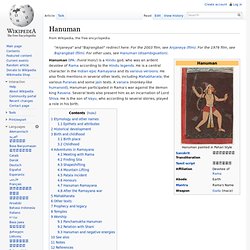
He is a central character in the Indian epic Ramayana and its various versions. He also finds mentions in several other texts, including Mahabharata, the various Puranas and some Jain texts. A vanara (monkey-like humanoid), Hanuman participated in Rama's war against the demon king Ravana. Several texts also present him as an incarnation of Lord Shiva. He is the son of Vayu, who according to several stories, played a role in his birth. Etymology and other names[edit] Indonesian Balinese wooden statue of Hanuman According to one theory, the name "Hanuman" derives from the proto-Dravidian word for male monkey (ana-mandi), which was later Sanskritized to "Hanuman" (see historical development below).
Epithets and attributes[edit] Nandi. Nāga. Naga stone worship at Hampi Nāga (IAST: nāgá, Burmese pronunciation: [naːɡá]) is the Sanskrit and Pāli word for a deity or class of entity or being, taking the form of a very great snake—specifically the king cobra, found in Hinduism, Buddhism, and Jainism.
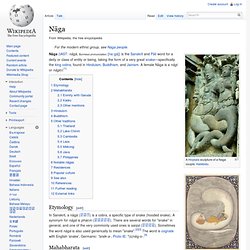
A female Nāga is a nāgī or nāgiṇī.[1] Garuda. In Hinduism[edit]

Ganesha. Shiva. Shiva (Śiva; /ˈʃɪvə/ listen meaning "The Auspicious One"), also known as Mahadeva ("Great God"), is a popular Hindu deity and is considered to be the Supreme God within Shaivism, one of the three most influential denominations in Hinduism.[1][2] Shiva is regarded as one of the primary forms of God, such as one of the five primary forms of God in the Smarta tradition,[1] and "the Destroyer" or "the Transformer"[3] among the Trimurti, the Hindu Trinity of the primary aspects of the divine.
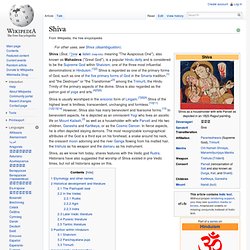
Shiva is also regarded as the patron god of yoga and arts.[4][5][6] Shiva, as we know him today, shares features with the Vedic god Rudra. Historians have also suggested that worship of Shiva existed in pre-Vedic times, but not all historians agree on this. Etymology and other names[edit] Vishnu. Vishnu's eternal and supreme abode beyond the material universe is called Vaikuntha, which is also known as Paramdhama, the realm of eternal bliss and happiness and the final or highest place for liberated souls who have attained Moksha.
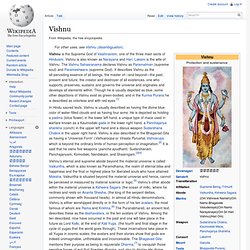
Vaikuntha is situated beyond the material universe and hence, cannot be perceived or measured by material science or logic.[5] Vishnu's other abode within the material universe is Ksheera Sagara (the ocean of milk), where he reclines and rests on Ananta Shesha, (the king of the serpent deities, commonly shown with thousand heads). In almost all Hindu denominations, Vishnu is either worshipped directly or in the form of his ten avatars, the most famous of whom are Rama and Krishna.[6] The Puranabharati, an ancient text, describes these as the dashavatara, or the ten avatars of Vishnu.
Name[edit] A 4th–6th century CE Sardonyx seal representing Vishnu with a worshipper. The inscription in cursive Bactrian reads: "Mihira, Vishnu (left) and Shiva". Lady gaga. Great Depression. USA annual real GDP from 1910–60, with the years of the Great Depression (1929–1939) highlighted.

The unemployment rate in the US 1910–1960, with the years of the Great Depression (1929–1939) highlighted. In the 21st century, the Great Depression is commonly used as an example of how far the world's economy can decline.[2] The depression originated in the U.S., after the fall in stock prices that began around September 4, 1929, and became worldwide news with the stock market crash of October 29, 1929 (known as Black Tuesday). The Great Depression had devastating effects in countries rich and poor. Personal income, tax revenue, profits and prices dropped, while international trade plunged by more than 50%.
Unemployment in the U.S. rose to 25%, and in some countries rose as high as 33%.[3] Cities all around the world were hit hard, especially those dependent on heavy industry. Some economies started to recover by the mid-1930s. Start Economic indicators Causes General theoretical explanations. Anschluss. German and Austrian border police dismantle a border post.

Aryanization. This article is about the Nazi concept.

For a discussion of the spread of Indo-Aryan culture in South Asia, see Indo-Aryanization, Indo-Aryan migration or Out of India theory. Aryanization (German: Arisierung) is a term coined during Nazism referring to the forced expulsion of so-called "non-Aryans", mainly Jews, from business life in Nazi Germany and the territories it controlled.
It entailed the transfer of Jewish property into "Aryan" hands in order to "de-Jew the economy". Literally, 'aryanization' means "to make Aryan". Hermann Josef Abs. Hermann Josef Abs. Hermann Josef Abs (October 15, 1901 – February 5, 1994)[1] was a German banker. He was a member of the board of directors of Deutsche Bank from 1938 to 1945. After World War II (1957–1967) he was chairman of Deutsche Bank, and contributed to the reconstruction of the German economy. Conceptual artist Hans Haacke created a work in 1974 called Manet-PROJEKT '74, which was supposed to be displayed in the Wallraf-Richartz-Museum.[2] Manet-PROJEKT '74 was a "ten-panel work about the turbulent and surprising fate of a painting by Édouard Manet, Bunch of Asparagus (1880), as it passed through the hands of its various owners before being bought for the Wallraf-Richartz-Museum by an acquisition committee of the museum's friends.
Germany. Germany ( i/ˈdʒɜrməni/; German: Deutschland), officially the Federal Republic of Germany (German: Bundesrepublik Deutschland, pronounced [ˈbʊndəsʁepuˌbliːk ˈdɔʏtʃlant]),[7] is a federal parliamentary republic in western-central Europe. It consists of 16 constituent states, which retain limited sovereignty, and covers an area of 357,021 square kilometres (137,847 sq mi) with a largely temperate seasonal climate. Its capital and largest city is Berlin. Germany is a major economic and political power and traditionally a leader in many cultural, theoretical and technical fields.
§Etymology §History §Prehistory §Germanic tribes and Frankish Empire Second- to fifth-century migrations in Europe. Bavaria. The Free State of Bavaria (German: Freistaat Bayern, pronounced [ˈfʁaɪʃtaːt ˈbaɪ.ɐn] ( ), Alemannic German: Freistaat Bayre, Austro-Bavarian: Freistoot Boarn, Main-Franconian: Freischdood Bayan) is a state of Germany, located in the southeast. With an area of 70,548 square kilometres (27,200 sq mi), it is the largest state by area, forming almost 20% of the total land area of Germany. Bavaria is Germany's second most populous state (after North Rhine-Westphalia), with 12.5 million inhabitants. Munich. Munich (/ˈmjuːnɪk/; German: München, pronounced [ˈmʏnçən] ( ),[2] Bavarian: Minga) is the capital and largest city of the German state of Bavaria. It is located on the River Isar north of the Bavarian Alps. Suicide in India. India's suicide rate per 100,000 people compared to other countries, according to the World Health Organization, Geneva.
Peeter Värnik[1] claims China, India, Russia, USA, Japan, and South Korea are the biggest contributors to the absolute number of suicides in the world. Värnik claims India's adjusted annual suicide rate is 10.5 per 100,000, while the suicide rate for the world as a whole is 11.6 per 100,000. About 800,000 people commit suicide worldwide every year,[2] of these 135,000 (17%) are residents of India,[3] a nation with 17.5% of world population. Between 1987 to 2007, the suicide rate increased from 7.9 to 10.3 per 100,000,[4] with higher suicide rates in southern and eastern states of India.[5] In 2012, Tamil Nadu (12.5% of all suicides), Maharashtra (11.9%) and West Bengal (11.0%) had the highest proportion of suicides.[3] Among large population states, Tamil Nadu and Kerala had the highest suicide rates per 100,000 people in 2012. Taranis. History of Japan. Revolutions of 1989. Rumi. Jalāl ad-Dīn Muhammad Balkhī (Persian: جلالالدین محمد بلخى), also known as Jalāl ad-Dīn Muhammad Rūmī (Persian: جلالالدین محمد رومی), Mawlānā or Molānā (Persian: مولانا, meaning Our Master), Mawlawī or Molavi (Persian: مولوی, meaning My Master), and more popularly in the English-speaking world simply as Rumi (30 September 1207 – 17 December 1273), was a 13th-century Persian[1][6] poet, jurist, theologian, and Sufi mystic.[7] Iranians, Turks, Afghans, Tajiks, and other Central Asian Muslims as well as the Muslims of South Asia have greatly appreciated his spiritual legacy in the past seven centuries.[8] Rumi's importance is considered to transcend national and ethnic borders.
Habsburg Monarchy. The Unconscious God. Existential therapy. Background[edit] Die Sexualität im Kulturkampf. Oedipus complex. Revolutions of 1848 in the Austrian Empire. May 1968 events in France. Sigmund Freud. List of Holocaust survivors. Viktor Frankl. Alfred Adler. Australian contribution to the Allied Intervention in Russia 1918–19. Military history of Australia during the Second Boer War.